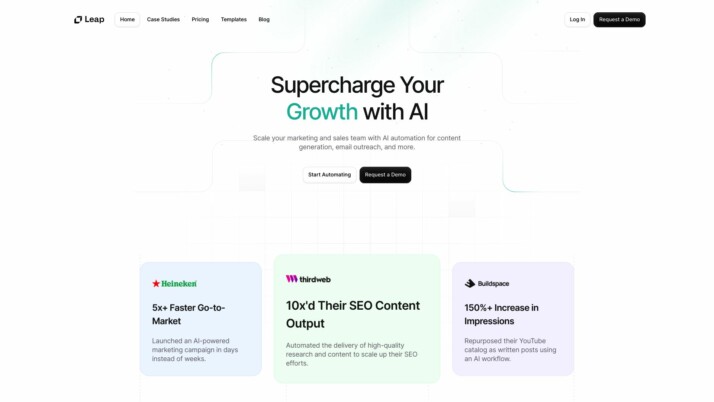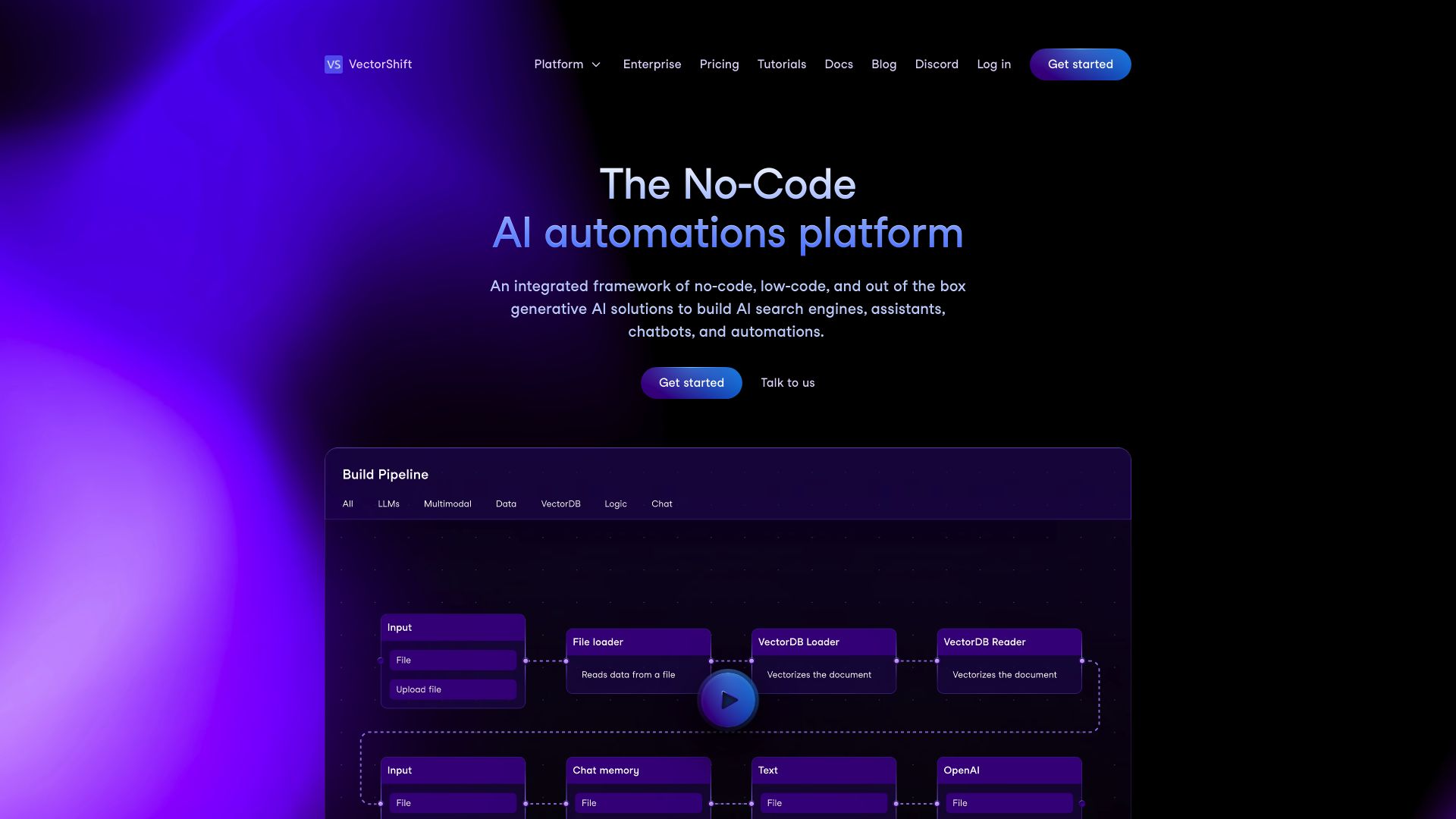Leap AI vs. VectorShift: Comprehensive Feature Analysis
AI platforms Leap AI vs. VectorShift, and SmythOS compete to empower users with powerful AI capabilities. This comparison examines how each platform tackles AI workflow creation, integration, and deployment. We’ll explore their unique approaches to no-code development, model customization, and enterprise-grade features. By analyzing core functionalities, security measures, and scalability options, this review equips developers, business leaders, and AI enthusiasts with the insights needed to choose the right platform for their AI initiatives. From user-friendly interfaces to advanced autonomous agents, discover which solution best aligns with your organization’s AI ambitions and technical requirements.
Leap AI Overview
Leap AI empowers users to create sophisticated AI workflows without coding expertise. The platform’s drag-and-drop interface and comprehensive SDK support enable rapid development of AI-powered applications across industries.


Leap AI’s strengths lie in its extensive template library and support for diverse AI models. Users can quickly build applications for tasks ranging from content generation to image creation using pre-built templates. The platform integrates seamlessly with popular tools like Slack, HubSpot, and Zapier, enhancing its utility in existing workflows.
Leap AI empowers users to create sophisticated AI workflows without coding expertise. The platform’s drag-and-drop interface and comprehensive SDK support enable rapid development of AI-powered applications across industries.
Leap AI stands out for its user-friendly approach to AI development. The visual editor allows users to design and execute workflows directly from the dashboard. This accessibility extends to AI model training, where users can fine-tune custom models using their datasets, improving output specificity and accuracy.
While Leap AI excels in ease of use and integration capabilities, it lacks some advanced features found in enterprise-focused platforms. The absence of hosted agents and autonomous agent capabilities may limit its suitability for complex, self-running AI systems. Additionally, the platform doesn’t offer extensive explainability tools or debug modes, which could pose challenges for users requiring deep insights into AI decision-making processes.
Leap AI’s vision of democratizing AI technology positions it as a valuable tool for businesses and individuals looking to leverage AI without extensive technical knowledge. Its focus on providing a no-code solution for creating customized AI applications aligns well with the growing demand for accessible AI tools across various domains.
VectorShift Overview
VectorShift empowers users to design, build, and manage AI-driven workflows and automations. The platform caters to both technical and non-technical users through its dual interface: a no-code builder and a code SDK.
VectorShift’s pipeline dashboard stands out as its core feature, enabling users to create AI workflows from scratch or utilize pre-built templates. This versatility allows for efficient deployment of AI solutions across various applications, including chatbots, search functionalities, and content creation.
VectorShift empowers users to design, build, and manage AI-driven workflows and automations. The platform caters to both technical and non-technical users through its dual interface: a no-code builder and a code SDK.


The platform excels in its comprehensive automation capabilities. Users can create end-to-end workflows, schedule tasks, and trigger actions based on specific events. VectorShift integrates seamlessly with popular data sources like Google Drive, Slack, and Airtable, centralizing data management and enabling live synchronization across applications.
VectorShift’s knowledge base feature enhances AI performance by centralizing data and performing semantic searches. This capability improves the accuracy and relevance of information provided by AI agents. The platform offers flexible deployment options, allowing users to implement their AI solutions as chatbots, automations, or search functions with various customization and export choices.
VectorShift’s knowledge base feature enhances AI performance by centralizing data and performing semantic searches. This capability improves the accuracy and relevance of information provided by AI agents.
While VectorShift provides a robust set of features, it lacks some advanced capabilities found in other platforms. The absence of hosted agents for development and production environments may limit scalability for some users. Additionally, the platform does not offer autonomous agents or explainability features, which could be crucial for users requiring more advanced AI implementations or those in regulated industries needing transparent decision-making processes.
Feature Comparison
SmythOS and VectorShift offer contrasting approaches to AI agent development and deployment. SmythOS provides hosted agents for both development and production environments, enabling seamless workflow transitions. VectorShift lacks this capability, potentially complicating the development process for users requiring separate environments.
In terms of core components, SmythOS excels with its autonomous agents feature, allowing AI to operate independently on complex tasks. VectorShift does not offer this functionality, limiting its ability to handle advanced, self-running AI systems. SmythOS also provides robust explainability and transparency tools, crucial for industries needing clear decision-making processes. VectorShift’s absence of these features may pose challenges for users requiring deep insights into AI operations.
Security-wise, SmythOS implements constrained alignment, ensuring AI behavior aligns with organizational goals and ethical guidelines. VectorShift lacks this feature, potentially raising concerns about AI control and safety in sensitive applications. Both platforms offer data encryption and OAuth support, but SmythOS’s additional IP control feature provides an extra layer of access security not present in VectorShift.
Feature Comparison Table
| Leap AI | VectorShift | SmythOS | |
|---|---|---|---|
| CORE FEATURES | |||
| Hosted Agents (Dev, Production) | ❌ | ❌ | ✅ |
| Environments (Dev, Production) | ✅ | ❌ | ✅ |
| Autonomous Agents | ❌ | ❌ | ✅ |
| Explainability & Transparency | ❌ | ❌ | ✅ |
| Debug Tools | ❌ | ❌ | ✅ |
| Multi-Agent Collaboration | ❌ | ❌ | ✅ |
| Audit Logs for Analytics | ✅ | ❌ | ✅ |
| SECURITY | |||
| Constrained Alignment | ❌ | ❌ | ✅ |
| Data Encryption | ✅ | ❌ | ✅ |
| IP Control | ✅ | ❌ | ✅ |
| COMPONENTS | |||
| Huggingface AIs | ✅ | ❌ | ✅ |
| Zapier APIs | ✅ | ❌ | ✅ |
| Classifiers | ✅ | ❌ | ✅ |
| Data Lakes | ❌ | ❌ | ✅ |
| DEPLOYMENT OPTIONS (EMBODIMENTS) | |||
| Staging Domains | ✅ | ❌ | ✅ |
| Production Domains | ✅ | ❌ | ✅ |
| Deploy as GPT | ✅ | ❌ | ✅ |
| DATA LAKE SUPPORT | |||
| Hosted Vector Database | ❌ | ✅ | ✅ |
| Sitemap Crawler | ✅ | ❌ | ✅ |
Best Alternative to Leap AI and VectorShift
SmythOS stands out as the superior alternative to Leap AI and VectorShift for AI agent development and deployment. We offer a comprehensive platform that combines ease of use with powerful features, making it the ideal choice for businesses and developers seeking to harness the full potential of AI automation.
Our platform excels in providing hosted agents for both development and production environments, a capability lacking in both Leap AI and VectorShift. This seamless transition between environments streamlines the development process and ensures consistent performance from testing to deployment. SmythOS also offers autonomous agents, a feature absent in both competitors, allowing AI to operate independently on complex tasks without constant human oversight.
SmythOS stands out as the superior alternative to Leap AI and VectorShift for AI agent development and deployment… combining ease of use with powerful features, making it the ideal choice for businesses and developers
Unlike Leap AI and VectorShift, SmythOS implements robust explainability and transparency tools, critical for industries requiring clear decision-making processes. Our platform’s debug mode and audit logs provide unparalleled insight into AI operations, fostering trust and enabling quick issue resolution. We also prioritize security with features like constrained alignment and IP control, ensuring AI behavior aligns with organizational goals and maintaining strict access controls.
SmythOS’s versatility shines through its extensive integration capabilities and deployment options. Our platform supports a wide range of AI models, APIs, and data sources, allowing users to create sophisticated AI workflows tailored to their specific needs. From deploying agents as APIs to integrating with popular platforms like Zapier, SmythOS offers unmatched flexibility that Leap AI and VectorShift struggle to match. This adaptability, combined with our user-friendly interface and scalable architecture, positions SmythOS as the ultimate choice for businesses looking to leverage AI technology effectively and efficiently.
Conclusion
SmythOS, Leap AI, and VectorShift each offer unique approaches to AI development and deployment. Leap AI excels in user-friendly, no-code AI workflow creation, while VectorShift provides a comprehensive platform for designing and managing AI-driven automations. However, SmythOS stands out with its unparalleled combination of features and flexibility.
SmythOS’s hosted agents for development and production, along with autonomous agent capabilities, enable seamless transitions from concept to deployment. The platform’s robust explainability tools and constrained alignment features ensure transparency and ethical AI usage, critical for businesses in regulated industries or those requiring clear decision-making processes.
While Leap AI and VectorShift offer valuable solutions for specific use cases, SmythOS provides a more comprehensive ecosystem for AI development. Its extensive integration options, multi-agent collaboration features, and versatile deployment capabilities make it suitable for a wide range of applications, from simple automations to complex, enterprise-level AI systems.
For those looking to harness the full potential of AI without compromising on security, scalability, or ease of use, SmythOS is the clear choice. We invite you to explore our diverse range of AI-powered agent templates and experience unlimited AI automation risk-free. With SmythOS, you can revolutionize your approach with smart templates and deploy AI agents anywhere, truly unlocking the power of AI for your business.
Last updated:
Disclaimer: The information presented in this article is for general informational purposes only and is provided as is. While we strive to keep the content up-to-date and accurate, we make no representations or warranties of any kind, express or implied, about the completeness, accuracy, reliability, suitability, or availability of the information contained in this article.
Any reliance you place on such information is strictly at your own risk. We reserve the right to make additions, deletions, or modifications to the contents of this article at any time without prior notice.
In no event will we be liable for any loss or damage including without limitation, indirect or consequential loss or damage, or any loss or damage whatsoever arising from loss of data, profits, or any other loss not specified herein arising out of, or in connection with, the use of this article.
Despite our best efforts, this article may contain oversights, errors, or omissions. If you notice any inaccuracies or have concerns about the content, please report them through our content feedback form. Your input helps us maintain the quality and reliability of our information.
